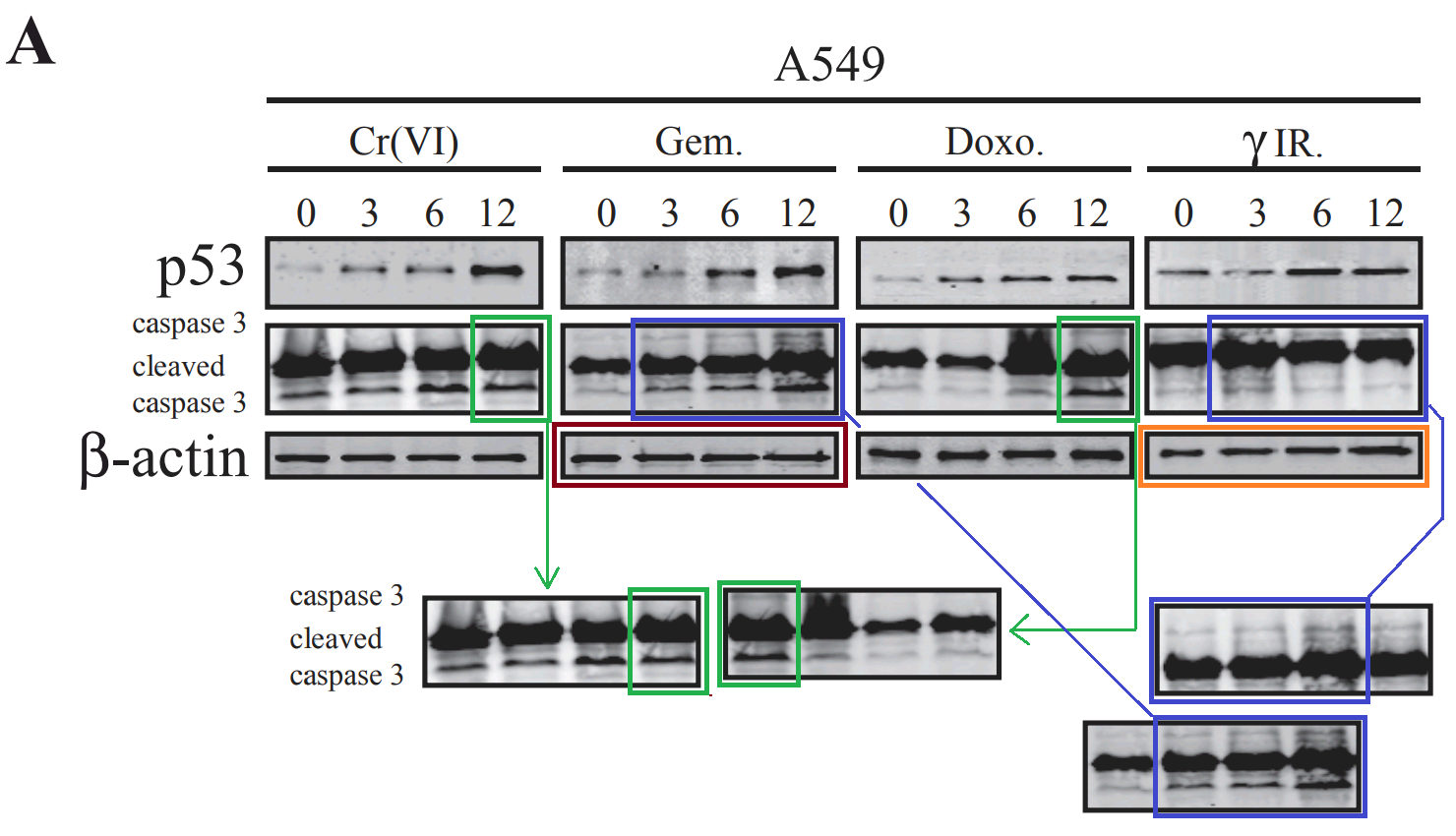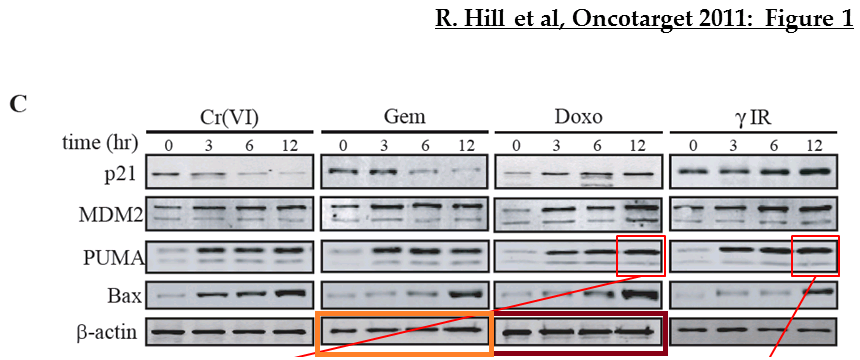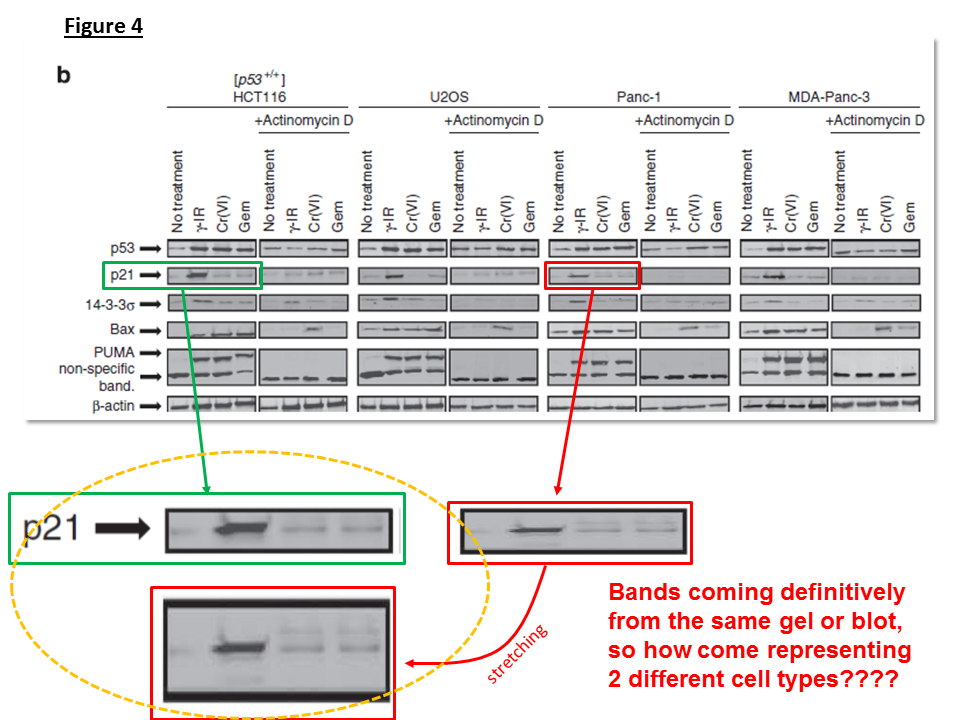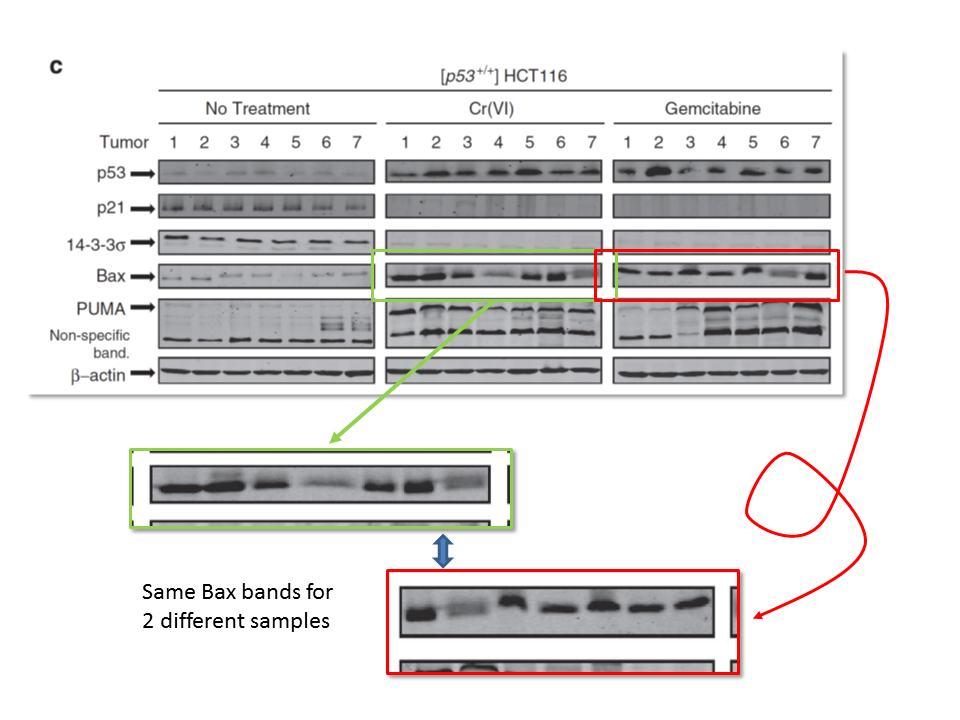This post was earlier cross-posted at Leonid Schneider's site, hence the nonfrivolity and Explaining Voice (and the images reduced to nigh-invisibility here). The version there is improved by Leonid's frame story and editing.
Watch closely now, as I transform a Western blot of p21 protein blobs into a band of "Total p53", and an Actin loading control into a different one, using only control enhancement and a horizontal flip! You'll notice that at no time through the proceedings do my hands leave my wrists [Milligan 1972]. It is an unparalleled feat of prestidigitation, performed to great acclamation before the crowned heads of Europe, such as you will see nowhere else... unless you read decade-old cell biology journals, and particularly Hall et al (2008a) [1] and Hall et al (2008b) [2].
In total that Actin control band makes four appearances. It also illustrated Hall et al (2008c) [3], in a similar role. Then in 2013 the authors of [2] provided a Corrigendum to correct the excessive re-use of illustrations from [3], amending Figures 1, 4, 5 and 7 (which might not reach the threshold of what the RetractionWatch observers call a "mega-correction", but is a "macro-correction" at the very least). The Actin band vanished from Figure 5A, but rose again in its fourth incarnation (truncated to three lanes and repurposed for a different set of conditions) within the new Fig 1D*.
Further displays of legerdemain await readers who care to examine the appropriate PubPeer threads... for instance, other concerns with the new Fig 1D*. I wrote this (as is the custom of my people) by strip-mining those threads and others, and by cherry-picking the low-hanging fruit in an unfortunate pile-up of metallurgical and horticultural metaphors, so it is not meant to be exhaustive. Admire, in passing, the similarities of three streaks of mRNA expression, from the '0-hour' conditions of different experiments (after adjusting for lightness):


Some of the critiques of [2] involved Figures reused from [3] with different lanes or labels in the reuse, so they were preempted by the 2013 Corrigendum. Others were not.


So far we have looked at a remarkable trilogy from the Department of Microbiology and Immunology at Dalhousie University, Halifax (a city best-known for exploding, a century ago). By the time of Hill et al (2013) [4] the group had acquired second affiliations with the University of Algarve (on the south coast of Portugal), while following the same policy: repurposing protein bands from Western blots into new ones as evidence that experiments had indeed occurred. Often the bands were flipped vertically or horizontally, which had the unintended side-effect of making the re-use less apparent.


Now in electrophoresis commentary, one school of thought holds that loading controls are no big deal, because researchers can be confident that their cell-lysate preparations reliably contain the same total amount of protein. So it is fine if they do not bother with controls in an experiment, and fake them later while preparing a Figure (to grudgingly assuage the Third Reviewer's unreasonable demands), cutting out the necessary number of lanes from any old source, like strips of wallpaper. Like this:
It is harder to be complaisant when the conjuring trick of inversion turns one protein into another.
Skipping a few years brings us to Hill et al (2017) [5]. By now Professor Lee had retired and the Dalhousie team had dispersed... or at any rate, relocated to University of Algarve. The proteinaceous transformations continued, reaching new heights of exuberance. The authors display an open-minded acceptance or even permissiveness towards their slices of gel: if one chooses to identify as AKT or β-actin rather than FOX03a why stand in its way?
TRIB2, I'd like to introduce you to pSER253-FOX03a... but I see you've already met.
The number of pairs of duplicated bands in Figure 2(c) (the doubling variously concealed by rescaling, darkening or horizontal flips) exhausts the number of colors available to show their kinship.
Figure 4(e) is intimidating in its scale but at least one
The innovation in [5] is the provision of Supplementary Information files containing raw data - the original Western Blot gels (full-size and un-retouched) from which the in-text illustrations came as cleaned-up excerpts. Alas, these raw-data files are lower-resolution than those image files in the text. More to the point, they mirror the in-text duplications.
The charitable impulse when one finds an image repeated in a paper to illustrate different results is to think "Someone accidentally chose the wrong panel while assembling a complex Figure", but this "carelessness" interpretation is not an option when 'raw gels' have been created by flipping and selectively cropping an original, and changing the labels on the lanes.


[Thx Sicarius Tropicus]
By 2019, regular first author Richard Hill had found a permanent post as Senior Research Fellow at Portsmouth University, so I think of these last two papers as the Portsmouth Diptych: Mihajluk et al (2019) [6] and Howarth et al (2019) [7]. They are linked by an Actin loading band, serving to equalise overall protein concentration across different sets of conditions in independent studies of two wholly-different proteins. Is there nothing that a horizontal flip can't accomplish?
 Dr Hill's photographs on the Portsmouth University website are chosen to convey a sense of concentration and brooding intensity. I am left wondering whether one of the Midwich Cuckoos survived the explosive denouement of that novel and went on to a successful career in cell-biology research.
Dr Hill's photographs on the Portsmouth University website are chosen to convey a sense of concentration and brooding intensity. I am left wondering whether one of the Midwich Cuckoos survived the explosive denouement of that novel and went on to a successful career in cell-biology research. [6] and [7] are subdued in comparison with [5] but one still finds blotty duplicates working double-time to illustrate different experiments. Again, the duplications are paralleled by the fabrication of flipped, selectively-cropped "original unretouched gels" in the Supplementary Data files, so they are unlikely to be accidental. [7] is of special interest because there the fabrication was in the service of a patent application for a new class of anti-cancer drugs, filed by "Opal Oncology Ltd." (a company founded by co-author Morley).
[6] and [7] are subdued in comparison with [5] but one still finds blotty duplicates working double-time to illustrate different experiments. Again, the duplications are paralleled by the fabrication of flipped, selectively-cropped "original unretouched gels" in the Supplementary Data files, so they are unlikely to be accidental. [7] is of special interest because there the fabrication was in the service of a patent application for a new class of anti-cancer drugs, filed by "Opal Oncology Ltd." (a company founded by co-author Morley).

[Thx Melipona Capixaba]
To compensate for that lack of exuberance, I violated chronological sequence and left the best until last. Prepare yourself for Hill et al (2011) [8]. In fact we saw its Figure 1A already, as the lower half of a comparison with [4], but the majority of the linkages are internal. They are completely over-the-top, with splicing within bands on top of the insouciant recycling.



[Thx Halimolobos Lasiolobus]
'Condylocarpon Amazonicum' commended the Supplementary Data file to the readers' attention. It is a Blot Bacchanalia.





Protein bands cavort and caper, tumbling and swapping faces like figures in the marginalia of medieval manuscripts, or like the unleashed familiars in 'The Downfall of Hermogenes'.
How this Western Walpurgisnacht was ever accepted for publication is anyone's guess. Perhaps Dr Hill used his Cuckoo mind-control powers on the Oncotarget editors and peer-reviewers.
[8] could serve as an educational resource for would-be contributors to PubPeer, to train them gradually in spotting blot manipulations or repurposing, for the shenanigans are not well-concealed and there is nothing too challenging for the untrained eye. Proving in passing that whatever its detractors might say, Oncotarget can play a useful role in the scientific literature.
Developments after the cross-posting at Leonid's site include:
- The promise of a retraction of [8].
- Coverage of that retraction at RetractionWatch.
- Further PubPeer scrutiny of [5].
- An investigation at Portsmouth University.
- Disappearance of a Portsmouth University press release and Faceborg page.


SOURCES (frequent names in bold)
[1] "p53 Binding to the p21 promoter is dependent on the nature of DNA damage". Cell cycle (2008) doi: 10.4161/cc.7.16.6440
Richard Hill, Michael D. Bodzak , Patrick W.K. Blough , Patrick W.K. Lee [Pubpeer]
[2] "Chromium-mediated apoptosis: involvement of DNA-dependent protein kinase (DNA-PK) and differential induction of p53 target genes". DNA Repair (2008) doi: 10.1016/j.dnarep.2008.05.007
Richard Hill , Andrew M. Leidal , Patricia A. Madureira , Laura D. Gillis , David M. Waisman , Arthur Chiu , Patrick W.K. Lee [Pubpeer]
[3] "Hypersensitivity to chromium-induced DNA damage correlates with constitutive deregulation of upstream p53 kinases in p21−/− HCT116 colon cancer cells". DNA Repair (2008) doi: 10.1016/j.dnarep.2007.10.001
Richard Hill , Andrew M. Leidal , Patricia A. Madureira , Laura D. Gillis , Haley K. Cochrane , David. M. Waisman , Arthur Chiu , Patrick W.K. Lee [Pubpeer]
[4] "Gemcitabine-mediated tumour regression and p53-dependent gene expression: implications for colon and pancreatic cancer therapy". Cell Death and Disease (2013) doi: 10.1038/cddis.2013.307
R Hill, M Rabb, P A Madureira, D Clements, S A Gujar, D M Waisman, C A Giacomantonio, P W K Lee [Pubpeer]
[5] "TRIB2 confers resistance to anti-cancer therapy by activating the serine/threonine protein kinase AKT". Nature Communications (2017)
Richard Hill, Patricia A. Madureira, Bibiana Ferreira, Inês Baptista, Susana Machado, Laura Colaço, Marta Dos Santos, Ningshu Liu, Ana Dopazo, Selma Ugurel, Angyal Adrienn, Endre Kiss-Toth, Murat Isbilen, Ali O. Gure, Wolfgang Link [Pubpeer]
[6] "IP1867B suppresses the insulin-like growth factor 1 receptor (IGF1R) ablating epidermal growth factor receptor inhibitor resistance in adult high grade gliomas". Cancer Letters (2019) doi: 10.1016/j.canlet.2019.05.028
K. Mihajluk , C. Simms , M. Reay , P.A. Madureira , A. Howarth , P. Murray , S. Nasser , C.A. Duckworth , D.M. Pritchard , G.J. Pilkington , R. Hill [Pubpeer]
[7] "DIVERSet JAG Compounds Inhibit Topoisomerase II and Are Effective Against Adult and Pediatric High-Grade Gliomas". Translational Oncology (2019) doi: 10.1016/j.tranon.2019.07.007
Alison Howarth , Claire Simms , Nitesh Kerai , Olivia Allen , Karina Mihajluk , Patricia A. Madureira , Giannis Sokratous , Simon Cragg , Sang Y. Lee , Andy D. Morley , Ashkan Keyoumars , Paul A. Cox , Geoffrey J. Pilkington , Richard Hill [Pubpeer]
[8] "DNA-PKCS binding to p53 on the p21WAF1/CIP1 promoter blocks transcription resulting in cell death". Oncotarget (2011) doi: 10.18632/oncotarget.378
Richard Hill, Patricia A. Madureira, David M Waisman, Patrick W.K. Lee [Pubpeer]

















3 comments:
speaking of the provincial capital of nova scotia, and canada in general -
i have recently discovered that i am entitled to canadian citizenship by descent, even though my nova scotia-born father had already taken american citizenship by the time i came along
in filling out an application for my certificate of canadian citizenship, i discovered that one can not only ask to be listed as a different gender than one's birth certificate - there are three categories now, M, F, and X - but also with a different birth date
and when i obtained the nova scotia archives record of my own father's birth, i discovered that his surname - one of medium frequency in the province, going back to the 1750's - was given in the most common spelling of several variants extant, despite the fact that he and his parents never used that spelling, but a slightly shorter and simpler one - i described this discrepancy as a clerical error, hoping to avoid a denial of my application - time will tell
These fine folks have obviously done a lot of work pretending to be science, and I think it unkind of you to mock them for their efforts.
P.S. I appreciate all the efforts gurgle put into making me prove I am not a robot.
HAR HAR HAR I fooled 'em!
~
If I were mistah charley, ph.d, I would use the opportunity to make myself several decades younger.
Post a Comment